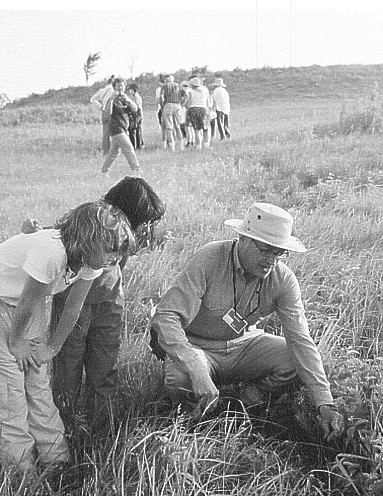
Katie and Larisa bend down to check out a prairie plant.
Snapshots by Gloria Freeland - June 20, 2002
A walk through the prairie
"God-forsaken place." That's the phrase I've heard my mother-in-law use when she's describing Kansas. I suppose to someone who grew up in Wisconsin, with its thousands of natural lakes and millions of acres populated by pines, my home state may seem plain.
But it seemed anything but plain to me as our group made its way along the trails of the Konza Prairie earlier this month. The colors are what struck me the most - vivid orange, soft purple, buttery yellow, delicate white and many shades of green.
There were about seven or eight groups of us, trekking along trails leading up to Butterfly Hill. Earl Allen was the guide for our group of about 12 people. He gave us each a phenological checklist of Konza Prairie plants. We learned that phenology is a branch of science dealing with the relations between climate and periodic biological phenomena such as bird migration or plant flowering.
It was interesting how differently people in our group reacted. The children and older people in the group seemed to pay the most attention to the guide, but even their reactions were different. My youngest and my sister's youngest bent down to closely examine and touch each plant that our guide identified, while the older people kept within earshot, asking him to repeat names if they didn't hear them the first time. The teenagers in our group - my oldest, Gaila's oldest and their friend Vanessa - seemed more interested in just enjoying nature. They especially enjoyed the warm south wind that "blew" us along once we topped Butterfly Hill. Maybe there's part of me that's still a teenager, too.
I was able to keep track of some of the plants - butterfly milkweed, Missouri evening primrose, sumac, wild raspberry, old plainsman, lead plant, daisy fleabane, prairie wild rose, echinacea and prairie larkspur. Whether I'd actually be able to match the plants with their names again would be another story.
For those in the group such as my sister's girls and Vanessa who don't call Kansas home, our guide explained that the word Konza - Kanza or Kansa to the Native Americans - means "people of the south wind." It was that description which gave our state and this small section of one of the few remaining tall grass prairies in the world their names.
He mentioned that the Konda has more than 600 species of plants, and part of the research, education and conservation of the prairie depends on keeping track of which plants are found when and what time of year they flower.
Although we never saw them, we heard bobwhites calling to their neighbors, while a dickcissel - similar to but smaller than a meadowlark - perched at the top of a nearby tree and sang its song. We learned that the upland sandpiper flies all the way to Tierra del Fuego in Argentina to spend the winter and returns to the prairie the following spring.
Daisy, the reserve's one-year-old bison, seemed to like us. She came right over to the fence and wanted us to rub her. Her brown wool was coming off in strips and our guide pulled some of it gently from her side to let us feel its softness.
When I first heard Art's Mom call my home that "God-forsaken place," it hurt my feelings. But as I've gotten to know her better over the years, I can see the small smile at the corner of her mouth when she says it, waiting to see what reactions she'll get from her listeners. And each spring when she comes to visit, she always mentions how beautiful the redbuds, flowering crabs, forsythia and Bradford pears are and how much nicer our springs are than the cold, damp, gray ones of Wisconsin.
This spring, as my sister and her girls were looking forward to their annual trip to Kansas, Vanessa's parents gave her the option of going to Italy for a few days or spending that time with us in Kansas. I think she made a good choice.

Katie and Larisa bend down to check out a prairie plant.